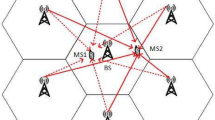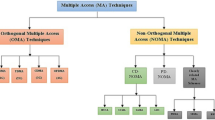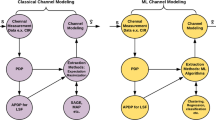Abstract
In wireless communication channels, the signals arriving at the receiver may be of stochastic nature or be superpositioned due to non-uniform scattering and shadowing. For the ease of computation, we generally assume the mean ergodic property of communication channels which is error prone. The well known lognormal model fails to capture the extreme tail fluctuations in the presence of shadowing. In this setting, we exploit the importance of Tsallis non-extensive parameter ‘q’ to characterize various fading channels. The q-lognormal distribution captures the tail phenomena due to presence of non-extensive parameter ‘q’. In this paper, we provide an excellent agreement between the generated synthetic signal and the proposed q-Lognormal distribution for different values of parameter ‘q’. This paper also presents the analytical expression for the superstatistics Weibull/q-lognormal model to capture both fading and shadowing effects. It is observed that the Weibull/q-Lognormal model provides a better fit to the generated signal for \(q=1.8\) in comparison to the well known Weibull/Lognormal model. Finally, we provide an excellent agreement between the derived measures viz., amount of fading, outage probability, average channel capacity with extensive Monte-Carlo simulation scheme.











Similar content being viewed by others
References
Simon, M. K., & Alouini, M. S. (2005). Digital communication over fading channels (Vol. 95). Hoboken: Wiley.
Shankar, P. M. (2017). Fading and shadowing in wireless systems. Berlin: Springer.
Rappaport, T. S. (1996). Wireless communications: Principles and practice (Vol. 2). Upper Saddle River: Prentice Hall PTR.
Sagias, N. C., & Karagiannidis, G. K. (2005). Gaussian class multivariate Weibull distributions: Theory and applications in fading channels. IEEE Transactions on Information Theory, 51(10), 3608–3619.
Shankar, P. M. (2004). Error rates in generalized shadowed fading channels. Wireless Personal Communications, 28(3), 233–238.
Bithas, P. S., Sagias, N. C., Mathiopoulos, P. T., Karagiannidis, G. K., & Rontogiannis, A. A. (2006). On the performance analysis of digital communications over generalized-K fading channels. IEEE Communications Letters, 10(5), 353–355.
Laourine, A., Alouini, M. S., Affes, S., & Stphenne, A. (2009). On the performance analysis of composite multipath/shadowing channels using the G-distribution. IEEE Transactions on Communications, 57(4), 1162–1170.
Hashemi, H. (1993). The indoor radio propagation channel. Proceedings of the IEEE, 81(7), 943–968.
Adawi, N. S. (1988). Coverage prediction for cellular mobile radio system operating in the 800/900 MHz frequency band. IEEE Transaction on Vehicular Technology, 37(1), 3–72.
Sagias, N. C., Zogas, D. A., Karagiannidis, G. K., & Tombras, G. S. (2004). Channel capacity and second-order statistics in Weibull fading. IEEE Communications Letters, 8(6), 377–379.
El Bouanani, F., Ben-Azza, H., & Belkasmi, M. (2012). New results for Shannon capacity over generalized multipath fading channels with MRC diversity. EURASIP Journal on Wireless Communications and Networking, 2012(1), 336.
Karadimas, P., & Kotsopoulos, S. A. (2009). The Weibulllognormal fading channel: Analysis, simulation, and validation. IEEE Transactions on Vehicular Technology, 58(7), 3808–3813.
Singh, R., Soni, S. K., Raw, R. S., & Kumar, S. (2017). A new approximate closed-form distribution and performance analysis of a composite Weibull/log-normal fading channel. Wireless Personal Communications, 92(3), 883–900.
Beck, C., & Cohen, E. G. D. (2003). Superstatistics. Physica A: Statistical Mechanics and its Applications, 322, 267–275.
Senapati, D. (2016). Generation of cubic power-law for high frequency intra-day returns: Maximum Tsallis entropy framework. Digital Signal Processing, 48, 276–284.
Tsallis, C. (2004). Nonextensive statistical mechanics: construction and physical interpretation. Nonextensive Entropy, Interdisciplinary Applications, 1–53.
Singh, A. K., & Singh, H. P. (2015). Analysis of finite buffer queue: maximum entropy probability distribution with shifted fractional geometric and arithmetic means. IEEE Communications Letters, 19(2), 163–166.
Rajput, N. K., Ahuja, B., & Riyal, M. K. (2018). A novel approach towards deriving vocabulary quotient. Digital Scholarship in the Humanities, 33(4), 894–901.
Picoli, S, Jr., Mendes, R. S., Malacarne, L. C., & Santos, R. P. B. (2009). q-distributions in complex systems: A brief review. Brazilian Journal of Physics, 39(2A), 468–474.
Holtzman, J. M. (1992). A simple, accurate method to calculate spread-spectrum multiple-access error probabilities. IEEE Transactions on Communications, 40(3), 461–464.
Mathai, A. M., & Haubold, H. J. (2008). Special functions for applied scientists (Vol. 4). New York: Springer.
Abe, S., & Bagci, G. B. (2005). Necessity of q-expectation value in nonextensive statistical mechanics. Physical Review E, 71(1), 016139.
Namaki, A., Lai, Z. K., Jafari, G. R., Raei, R., & Tehrani, R. (2013). Comparing emerging and mature markets during times of crises: A non-extensive statistical approach. Physica A: Statistical Mechanics and its Applications, 392(14), 3039–3044.
Shankar, P. M. (2011). Statistical models for fading and shadowed fading channels in wireless systems: A pedagogical perspective. Wireless Personal Communications, 60(2), 191–213.
Lieblein, J. (1955). On moments of order statistics from the Weibull distribution. The Annals of Mathematical Statistics, 1, 330–333.
Chauhan, P. S., Tiwari, D., & Soni, S. K. (2017). New analytical expressions for the performance metrics of wireless communication system over Weibull/Lognormal composite fading. AEU-International Journal of Electronics and Communications, 82, 397–405.
Shannon, C. E. (2001). A mathematical theory of communication. ACM SIGMOBILE Mobile Computing and Communications Review, 5(1), 3–55.
Tiwari, D., Soni, S., & Chauhan, P. S. (2017). A new closed-form expressions of channel capacity with MRC, EGC and SC over lognormal fading channel. Wireless Personal Communications, 97(3), 4183–4197.
Adamchik, V. S., & Marichev, O. I. (1990, July). The algorithm for calculating integrals of hypergeometric type functions and its realization in REDUCE system. In Proceedings of the international symposium on Symbolic and algebraic computation(pp. 212–224). ACM.
Gradshteyn, I. S., & Ryzhik, I. M. (2014). Table of integrals, series, and products. New York: Academic press.
Author information
Authors and Affiliations
Corresponding author
Additional information
Publisher's Note
Springer Nature remains neutral with regard to jurisdictional claims in published maps and institutional affiliations.
Rights and permissions
About this article
Cite this article
Mukherjee, T., Singh, A.K. & Senapati, D. Performance Evaluation of Wireless Communication Systems over Weibull/q-Lognormal Shadowed Fading Using Tsallis’ Entropy Framework. Wireless Pers Commun 106, 789–803 (2019). https://doi.org/10.1007/s11277-019-06190-8
Published:
Issue Date:
DOI: https://doi.org/10.1007/s11277-019-06190-8




